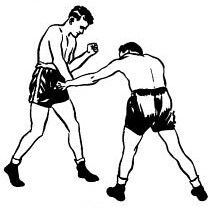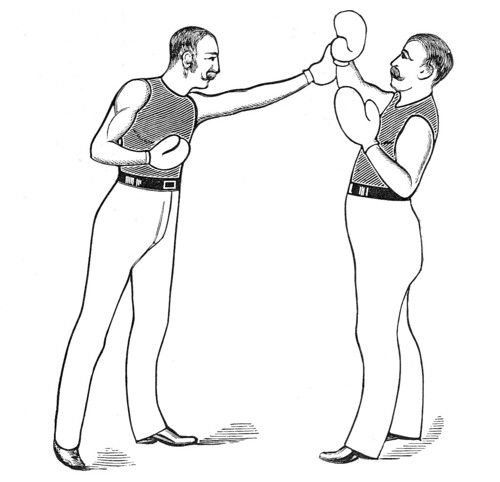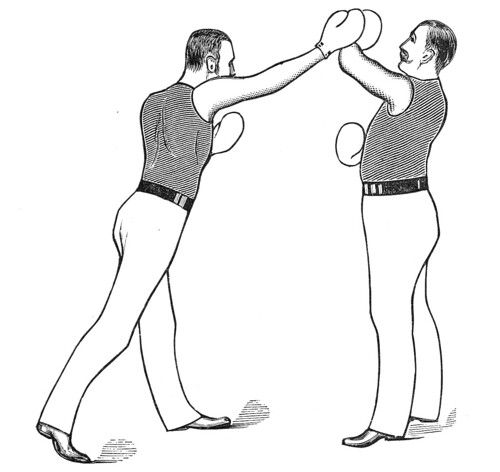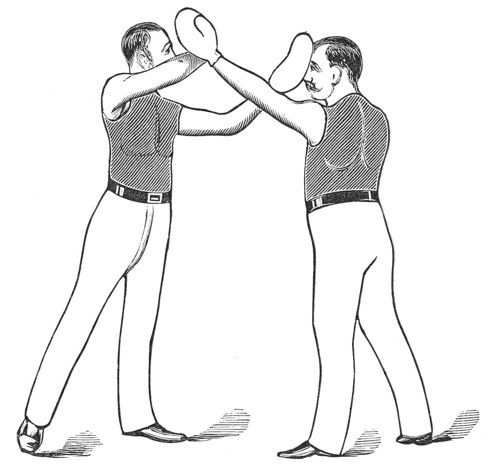Right, that's it, it's war!
The performance of the blocks in that video is completely off of anything I've ever taught or seen taught. Kirk's video is closer to how I do it, but not quite the same.
I agree on the idea of a defense from a downward sword cut. Makes sense... a long time ago. But what to do with it now? One thing I've shown in the past is this - say a man grabs you with both hands, on the chest/shirt area. Raise the arms in the 'i don't want any trouble, i give up' manner, then bring them downward into a traditional ready stance, striking the attacker in the elbows to bend the arms and bring him closer. Then do the 'block' delivering it as a strike underneath the chin while stepping forward. If you keep pressure, you can walk them off you. If you pop them hard, their head will snap back and they'll see stars long enough for you to get away.
I need to get a video camera, I think it'd make more sense to show instead of write out.
Well, yeah, a defence against a sword makes sense "a long time ago" (although maybe not as long as you might be thinking), are you suggesting that although the same movements have been kept, due to there not being a prevalence of sword attacks these days, the action needs to have a different use? Surely you'd either just drop the movement, or come up with a new one, yeah? Otherwise it's like saying "yeah, a ship is a good way to get to an overseas country, but once you're flying in a jet, the boat is rather useless... so let's make a boat fly!"
When looking at anything classed as a "traditional art", it pays to understand the context that the art came from... which means understanding what it was meant to face, rather than what you expect it to face now. And, in that sense, Tang Soo Do/Tae Kwon Do are really nothing more than Korean adaptations of Japanese Karate (hell, that's what Tang Soo Do means...), which is an adaptation from Okinawan Te. And, as such, that's the context that you should be looking at for the techniques. So saying that "well, yeah, a sword defence back then...", it's really what it is. What it's used for now, and the reason it's seen as being rather impractical, is that it's removed from the actual reason for it. For the record, it's the same with pretty much all the other blocks as well, and the kata tend to work best when taken with this idea in mind....
Now, to my nemesis, Kirk...
Well, my intent in the statement was humor.

Like I said, I've read that interpretation from others too so it's not like it's a secret (though, based on how few people seem to know this application, you'd think it was).
The "sweep across" one, you mean? As I said, I can see how it could be done that way, but I really don't think that's the actual application. It just doesn't make enough sense, on a number of levels.
No, no, no, Kirk, we're meant to fight! Have at thee, and all that! I mean, where's the fun, otherwise?
..... spoilsport.....
Naturally, I disagree. I suppose it wouldn't surprise you to know that I've seen and done it in almost exactly the way I described. Of particular note was the very slight hip winding instead of the exaggerated motion that I see usually taught. The issue is of timing. Unless the linear punch was very deep and very committed, most people simply do not have the time to push it that far. However, all of these Karate-based systems we're talking about are noted for teaching deep, committed, long, linear punches. There are 9 perfect examples in the video you just referenced.
Yeah, I'm not taking the methods of punching as validation, honestly. We'll come back to this.
Depends on the range. We'll come back to this.
Hey, you're stealing my lines! But okay, cool. I'd also say that my reasoning isn't really about the range, it's about the mechanics... coming up vertically like that just doesn't have much power for a strike... but is very strong (structurally) as a jamming action against something coming down, as it's a bracing structure, not a striking one. Yeah, it can be done, but it's just far from optimal.
My experience in knife arts tells me something different. My experience is that the final movement of a traditional "high block" is:
- A very poor defense against an ice-pick downward stab
- almost never taught in arts that teach knife use
- is taught very differently than this when it is taught
- Doesn't fit very well with the ways an ice-pick attack is usually made (see the section "How Attacks Are Made" in this article: http://cbd.atspace.com/articles/degenhawk/hawk_and_rondell.html )
Right, a few things here. First, I wasn't talking about knife attacks, and particularly not "ice-pick grips". You might have noticed that I was talking Japanese weapon attacks (thinking specifically about sword, but also kodachi, and, to a small degree, tanto), I spoke about "forearms" (plural), and the idea of an "ice-pick grip" just isn't really a major thing in Japanese systems. You're more likely to get knife methods with the edge up than a reverse-grip like you're describing here. But, uh, on that page you've linked? Check out images 17, 21, 24, which all show something along the lines of the application I'm talking about.... hmm....
This comes back to the range issue I noted above. If the defender steps forward, he is in the perfect place to drive the backfist (hammer fist, or whatever) into the opponent. It also matches the basic punching strategy (as opposed to the more advanced) illustrated in the basic forms: step into the strike.
Yes, and he's just stepped directly into an incoming strike. The fact that the attacking punch is such a long, deep stepping action just tells you the range they're attacking from, really, the end of the punch is going to be the same (your nose, or a few inches beyond it, really)... so, why are you moving directly into it? Just so you can hopefully sweep the incoming punch to the side and apply a weakened rising strike? Really? Additionally, by moving into the strike, you're not only making it closer, you're making the timing far tighter as well, as you're now giving yourself less time to actually get your interception and deflection in... so this application has you stepping straight into a punch with less reaction time and a low-impact response. Yeah, I'm really, really not sold as this for a primary application....
It works perfect if one assumes the opponent is stepping into his punch as is illustrated with all 9 punches in the form.
Er... no. See above.
I don't accept it as a moving in to the hands on the grip of a sword either. The timing is near impossible, certainly not "basic." Nor does it match with any other "unarmed against a sword" techniques I've ever seen. In particular it lacks the "voiding" movement which takes the defender's body out of the path of the sword.
Peace favor your sword,
Kirk
Well, it may not be exactly "basic" (it is, actually, but that's another story, and is done in another fashion initially... but that's another little-understood aspect of many old systems....), but it is very much standard almost across the board. In fact, almost every system I can think of has some form of it... in the Ninjutsu traditions, for example, five out of the six main systems have it, as do many many many other schools, such as Takenouchi Ryu, Asayama Ichiden Ryu, Kashima Shinryu, and, well, many many others. But the thing is, whenever this type of action comes up, it is never against a straight (forward) attack... it is only ever against a downward one, whether a sword attack, a short sword one, a knife attack (not an "ice-pick grip" again), or an unarmed hand strike (which, frankly, are just preparation exercises for the defence against weapons later on). In fact, this is such a standard response that there are famous martial poems in Japanese traditions, dealing with unarmed defence against swords, which advises the reason for this:
"Under an upraised sword is Hell. Step forward, and find Heaven." (Note: this is not a Christian form of Heaven, so it does not imply being killed....). The step forward gets you in past the range of the sword blade, allowing you to jam the forearms as the person attacks. That would be your "voiding" action, I believe.




